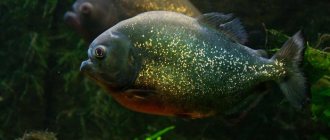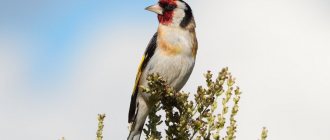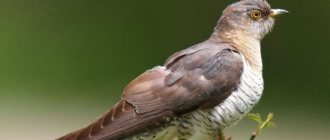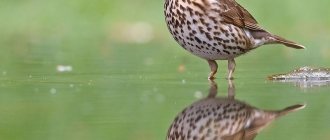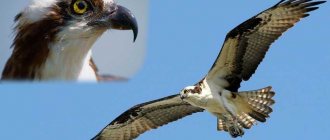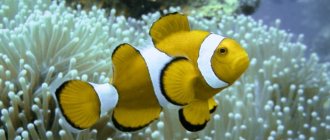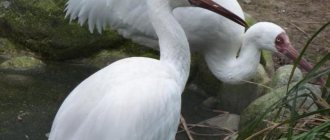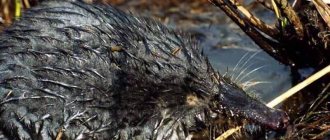04 October44021mustel family otterpredator pores
The river otter (other names: otter, common otter, otter) is a predatory animal that is a member of the Mustelidae family. The otter is a very interesting animal. The otter is an unsurpassed swimmer and skilled hunter; it is very dexterous and flexible. Below you will find a description and photo of a river otter, and you can also learn a lot of new and interesting things about this amazing animal.
Description and origin of the species
The animal received the first scientific description, and the scientific name Lutra lutra
from the Swedish zoologist Carl Linnaeus in 1758. The name "otter" came into Slavic languages from the ancient Indian udras, which literally means aquatic animal. In Latin the animal is called lutra, hence the name of the genus. The genus Lutra now includes only 2 species - the Sumatran and Eurasian otters, and the Japanese extinct species.
Animals living in the New World were also initially classified in the otter genus Lutra, but later they were separated into a separate genus Lontra (American otters). Now this genus includes 4 species - Canadian, cat, long-tailed and southern otters.
Clawless otters are also classified as a separate genus. Initially, these animals belonged to the genus of otters Lutra, but due to their peculiarity - the absence of claws, they were separated into a separate genus of clawless Aonyx. The name of the genus is translated from Latin as “without claws”, and is formed from the word onyx (claw) and the prefix a- (without). This genus includes 3 species - Asian, African and Congo clawless otter.
Other species—the sea otter, the Brazilian giant otter, the smooth-coated otter, and the white-throated otter—were also transferred from the genus Lutra to separate genera due to the unique morphological features of these animals.
Reproduction
Sexual maturity in these animals begins in the second/third year of life. Mating usually occurs in the spring, in water, and pregnancy lasts from one and a half to two and a half months. Usually two to four babies are born, and birth takes place in a burrow. The otter raises the cubs herself: despite the fact that the male is nearby at this time, after fertilization the female drives him away and does not feel a strong desire to see him near her. True, not everyone does this; for example, the eastern otter prefers to live in pairs and raise babies together with the male.
A newborn otter calf, like many mammals, is born blind, toothless, deaf, and covered in dark gray down. It begins to see quite late - after a month. By this time, their fur acquires the same color as that of their parents, and their weight reaches eight hundred grams. They begin to feed independently only from the age of two months, and begin to move a short distance from their mother only after reaching eight/nine months. True, by the age of one year the animals become completely independent, but still live with their family for some time.
Everything you need to know about killer whales146794.550
Types of otters
Today, the otter subfamily Lutrinae includes 13 species. The Japanese species Lutra nippon is considered extinct today.
European otter (Lutra lutra)
The most common species in the wild. Also known as the river, Eurasian, common or Old World otter. The animal lives in Europe, Asia, North Africa, the Far East and Kamchatka.
The animal weighs from 7 to 12 kg, the body does not exceed 1 meter in length. Some mature males can weigh up to 17 kg. The body length of the European otter averages from 57 to 95 cm, with a tail 35-45 cm long. Females are noticeably smaller than males.
Canadian otter (Lontra canadensis)
Also known as the North American or northern river otter. In size, habits and appearance it is very similar to the European otter. The animal is about 1 meter long and weighs 5-14 kg. Previously found throughout North America, the population has now declined significantly due to urbanization. The animals have virtually disappeared in the states of New Mexico, Oklahoma, North Dakota, Tennessee, Kansas, Nebraska, Arizona, Ohio, South Dakota and West Virginia.
Southern otter (Lontra provocax)
The southern river otter, despite the name "river", inhabits rivers and seacoasts in southern South America, Argentina and Chile. Some scientists consider the animal to be a subspecies of the Canadian otter. The animal is smaller in size than its European and North American relatives. The body length of the animal does not exceed 70 cm, the long tail is up to 40 cm. It weighs 5-10 kg.
Long-tailed otter (Lontra longicaudis)
Also known as the Neotropical river otter. It lives in Central and South America, and on the island of Trinidad. The most widespread of all American otters, the animal's habitat stretches from northern Mexico to central Argentina. The animal is distinguished by a long tail - with a body length of no more than 66 cm, the tail length ranges from 37 to 84 cm. The animal weighs 5-15 kg, and in other respects, except for the long tail, is very similar to its counterparts in South America and Canada.
Of all the otters, this is the most adaptable species - the animals are universal, they can live on rice and sugar plantations, in cold mountain lakes, on the seashore and in sea water. Along the banks of rivers and streams they live in areas of any terrain - in tropical forest, savannah, prairie, swamp. They rise to a height of up to 3,000 meters above sea level. They adapt well to climate changes.
Cat otter (Lontra felina)
Also known as the sea otter, it is a rare and poorly studied species of South American otters. The smallest otter of all, and the smallest marine mammal in the world. The animals weigh only 3-6 kg. The body length from the head to the tip of the tail varies from 87 to 115 cm, of which 30-36 cm is on the tail. In Spanish, the animal is called a sea cat, and the scientific name of the animal is similarly translated from Latin.
The animal differs from its relatives in that it lives only in sea water. Apart from the cat otter, this feature is characteristic only of the sea otter. The animal lives along the ocean coast along southwestern South America - from the coast of northern Peru, along the entire coast of Chile and to the very south of Argentina. The animals have also been spotted in the Falkland Islands.
White-throated otter (Hydrictis maculicollis)
Also known as the spotted or spotted otter. Lives in rivers and large lakes in sub-Saharan Africa, then south of 10 degrees north latitude. For an inexplicable reason, the animals are rarely found in East Africa, although the living conditions are quite suitable for them.
The animal is small in size - the body length does not exceed 70 cm, weighing on average 3-6 kg. Externally they differ in the presence of light spots on the chest and throat. The animals are very talkative, and often produce high, thin whistles and rapid chatter.
Sumatran otter (Lutra sumatrana)
The rarest otter in Asia, a little-studied and rare species. Lives in Southeast Asia - in southern Thailand, Cambodia, southern Vietnam, Malaysia, the islands of Sumatra and Borneo. Previously, the animal was found in India, Myanmar and Brunei, but most likely has already been exterminated in these countries. The initially small population is under great threat due to loss of natural habitat and poaching.
The animal weighs 5-8 kg. The body length is from 57 to 82 cm, the tail is from 35 to 50 cm long. The color is brown or reddish-brown, with white spots on the upper lip and chin. It differs from other otters in that short hair grows on the animal’s nose. Because of this, the animal is called the furry-nosed otter.
Brazilian otter (Pteronura brasiliensis)
Also known as the giant or giant river otter. The largest otter among freshwater species, and the longest member of the Mustelidae family. The body length of the animal reaches 1.7 meters, the powerful muscular tail adds about 70 cm. Males weigh on average 26-32 kg, females 22-26 kg.
Lives in the northeastern part of South America, along the banks of the Amazon and in the Pantanal swamps. The predators have lost 80% of their range in recent decades, but are still found in Brazil, Colombia, Ecuador, Venezuela, French Guiana, Guyana, Bolivia, Paraguay and Peru.
The animal is very loud and talkative, and makes more than 20 different sounds. Predators live in large groups of 4-8 individuals and hunt together. They regularly eat piranhas and are able to defeat an anaconda or black caiman with joint efforts.
The giant otter is the shortest-haired of all species. The fur is very dense, thick and waterproof, with guard hairs about 8 mm long and undercoat about 4 mm long. There are light spots on the animal's throat and chin, by which animals recognize each other. When meeting, predators show their throats to each other.
Smooth-coated otter (Lutrogale perspicillata)
Another name for the animal is the Indian otter. The largest otter in Southeast Asia. The animal weighs from 7 to 11 kg, body length is 59-64 cm with a tail of 37-43 cm. They live in India, Pakistan, Nepal, Bangladesh, southwest China, Myanmar, Thailand, Vietnam, Singapore, Malaysia, Brunei and the islands of Java, Sumatra and Borneo. Locally isolated populations have been seen in Iraq.
It has a smoother and shorter skin compared to the fur of other species. Unlike other otters, it has a more rounded head, a hairless nose and a flat tail (other species have round tails).
Eastern clawless otter (Aonyx cinerea)
Also known as the Asian clawless otter or simply the clawless otter. The smallest species of otter in nature. The animal weighs from 2.7 to 3.5 kg. The average body length is 47-61 cm, with a tail of about 26-35 cm. The habitat extends from India to Southeast Asia, some individuals were brought to England. They prefer mangrove and freshwater swamps as habitat.
The animal's claws are very short and do not extend beyond the paw pads, which allows them to use their fingers much more actively and hunt crabs and shellfish more effectively.
Cape clawless otter (Aonyx capensis)
Also known as the African clawless otter. It lives in Africa south of the Sahara, inhabits water bodies in savannas and wooded swampy lowlands. It is distinguished by the absence of claws on its paws.
The African clawless otter is the second largest freshwater otter species. The weight of the animal varies from 10 to 36 kg. The body length is 113-163 cm, plus a long tail, which accounts for about 1/3 of the body length. Despite the fact that the animal is the closest relative of the eastern clawless otter, these species differ in size by 2 times.
Sea otter (Enhydra lutris)
The sea otter, or sea otter, is the largest member of the Mustelidae family, but one of the smallest species of marine mammals. The weight of the animal varies from 14 to 45 kg, the body length reaches 1.5 meters. It has very dense waterproof fur and can reach speeds of up to 9 km/h in water.
Like the cat otter, the sea otter swims only in sea water and swims no further than 1 km from the shore. Found along the coastline of the Pacific Ocean, stable populations remain in the Far East, Alaska, California, Mexico, British Columbia and Japan.
Congo clawless otter (Aonyx capensis congicus)
Also known as the Cameroon clawless otter. Previously classified as a subspecies of the African clawless, it has recently been classified as a separate species. A rare and little-studied species, it lives only in central Africa - Congo, Cameroon, Angola, Burundi, Central African Republic, Nigeria, Ghana, Rwanda, Equatorial Guinea. The animal is large enough for an otter. The body length reaches 1 meter, plus a tail with a length of 40 to 70 cm. The predator weighs from 14 to 34 kg.
Appearance
The river otter has a rather pretty appearance. Her body size varies from 55 to 95 centimeters with a weight of about 10 kilograms. Due to its way of life, it has a lot of distinctive features in the form of a flexible and elongated body, a long tail, short paws with membranes between the toes. The muzzle of the river otter is small and slightly flattened, on which there are small roundish ears.
The eyes are dark and directed forward or upward. The river otter's body is covered with thick fur. The fur itself is quite coarse and shiny with a brown color that becomes lighter in the abdomen area. In winter, the fur becomes longer. Feet and hands without hair.
Sexual dimorphism lies in size: males are larger than females.
What does an otter look like?
The otter looks like a typical representative of the Mustelidae family - a long, flexible, squat body with short legs and a powerful, thick tail. The neck is quite short and muscular, a rounded head with a blunt muzzle, small rounded ears. The animal may close its ears and nostrils while diving.
It has sharp claws and webbing between the toes, although representatives of the genus Aonyx have very short claws or none at all. Otter fur is very dense and thick, almost waterproof. Species living in the tropics usually have shorter fur than northern species. The color is brown or brown with a reddish tint; the fur on the back is often darker, with a lighter shade underneath. The throat and chin are light in color or have white spots.
Characteristic
Since the river otter spends most of its life in the water , this is reflected in its behavior and habits.
- This animal belongs to the mustelid family, so it demonstrates the skills of a cunning hunter characteristic of its representatives.
- The food for this animal is fish, which is not difficult for an otter to catch.
- When moving on land, the animal's body looks slightly hunched over, but even this allows it to develop high running speed.
- If a person meets an otter on the ground, it will still be able to run away from him.
- The best place to build a home is in remote places where people rarely visit. Even though there will be little food in the place where they live, the otter will be more than happy with this, since this guarantees safety not only for him, but also for his offspring.
- This animal usually goes hunting in the morning and evening twilight. During strong winds and snowfalls, the otter prefers not to go outside and remains in its shelter for a long time.
- The otter is a very secretive and cautious animal that always looks around. It is very difficult to meet an otter in an open area on the shore. She also demonstrates secrecy when arranging her home, masking the exit from the water with spruce branches or creating it in places overgrown with bushes.
- The river otter is a fairly good-natured animal that loves to play. Therefore, if you decide to have it in your home, then you will not be bored.
Appearance
When someone mentions an otter, we usually associate it with something that has an unpleasant appearance. However, this animal does not correspond to this idea. She looks quite attractive , having a very funny face that looks beautiful thanks to her long sideburns.
- The top of the head is flat and lacks ears with rounded tips, which all members of the mustelid family have. However, even without this, the otter looks quite beautiful.
- The body has such a structure that it is ideal for swimming. The body has a streamlined, smooth shape, elongated in length, dense, tapering at the end, where the flat tail begins. Thanks to all these features, the otter can develop high speed in water.
- The animal has short front legs, which allows it to swim well.
- The basis of the animal's hair is formed by a thick awn, which fits tightly to the body. On the surface of the spine there is always a presence of fatty secretions that come from the skin glands. Thanks to this, the animal's coat never gets wet. The otter's belly has more hair than its back and sides.
- It is quite easy to distinguish a male from a female due to its size: males are usually larger than females.
This animal is highly valued because of its wear-resistant and waterproof fur , which is an excellent material for making warm and beautiful fur coats.
Habitat
The otter can be found throughout Western Europe, as well as in Asia.
She is also not a rare visitor near the southern border of Hindustan and China. The first representatives of this species were discovered in Greece, Spain, Great Britain and Switzerland, but quite soon their population disappeared, which was the result of active hunting for them. Experts, aware of the high risk of complete extinction of otters, are trying to create suitable housing for them on the lakes and reservoirs of these countries, but so far their attempts have not been particularly successful, and the otter is still on the list of endangered species. This animal feels most comfortable on rivers with fast currents and rocky bottoms. She loves narrow rivers about 10-15 m .
Today, the river otter numbers about 90 thousand individuals, which is very small considering the area of our planet.
Where does the otter live?
The otter lives mainly in fresh water; only 2 species prefer sea water - the sea otter and the cat otter. Otters always settle near water, although they can also move over long distances on land in search of habitat.
The animals are universal, and can live almost anywhere where there is water - in swamps and lowlands, on plains and savannas, in rice fields and sugar cane plantations, in tropical and deciduous forests, on the banks of small streams, lakes, deep rivers, on the seashore or ocean.
How do otters live?
Although many people consider otters to be nocturnal animals, they can easily lead an active lifestyle in the evening and even during the day if they believe that they are not in danger. Basically, these animals like to live alone, the only exception being females with children - young otters live with their mother for about a year and leave her only when she is about to reproduce again.
Among otters there are species that do not like loneliness. For example, the giant otter differs from its European relatives in that it is active during the day, is not very timid, lives in groups and hunts in schools: animals from different sides drive fish to one place.
Despite the fact that otters spend almost all their time in the water, many of them feel good on land, along which they move at a trot, leaving a winding trail, and often make one and a half meter long jumps. But on loose snow, due to their short limbs, they move with difficulty, at a gallop, hunched over greatly. If the snow is more or less compacted, otters alternate jumping with sliding on their belly.
These animals are also very energetic and playful. Not far from their holes you can find “roller coasters” - hills with a compacted trail left by the animal sliding on its belly. The animal climbs this hill several times a day and slides down with a running start. Another favorite pastime is catching one’s own tail or hind leg, and often plays with the caught fish, after which it eats it.
In summer, when there is a lot of food in the reservoir, otters live in one place and do not move far from the site. The animal feeds on fish, frogs, crabs, and also catches rodents and even birds. The otter's hunting grounds at this time of year range from 2 to 18 kilometers along the river and 100 meters inland from the shore. In winter, if the fish leave or the ice freezes, thereby making hunting difficult, the animal is quite capable of covering 15 to 20 kilometers in a day in search of food.
What does an otter eat?
The basis of the animal’s diet and its favorite food is fish. In winter and during the cold season, when there are fewer fish, the predator switches to other food sources - amphibians, crustaceans, insects, birds, small mammals. In addition to fish, the animals often eat crabs, frogs, turtles, worms, snakes and rats.
Canadian otters often hunt ducks, turtles and beavers. Giant otters are the single dominant predator in their habitat, and will eat almost any animal common in their habitat. Attacking in small groups, Brazilian giant otters successfully hunt even caimans and anacondas.
Otters eat about 10% of their body weight per day. Giant otters eat about 3 kg per day, North American and Eurasian otters - from 1 to 1.5 kg. Animals drag large prey ashore, and eat small prey directly in the water.
These amazing animals
An otter (lat. Lutra) is a predatory mammal that leads a semi-aquatic lifestyle and belongs to the mustelid family. The subfamily has 5 genera and 17 species, among which the most famous are the common (river) otter, sea otter, sea otter, Brazilian (giant) and Caucasian otter. All species of this animal are listed in the International Red Book: the valuable otter fur has been attracting the attention of poachers for centuries.
Descriptions of otters of different genera differ depending on the species. Thus, the length of the animal’s body ranges from 55 to 95 cm, while it is very flexible, muscular and long. The length of the tail ranges from 22 to 55 cm, it is thick at the base, tapering towards the end, and is not fluffy. The largest is considered to be the Brazilian or giant otter, which lives on the banks of the Amazon and Orinoco: together with the tail, the length of this animal reaches two meters, and its weight is more than twenty kilograms.
Thus, the giant otter is the largest representative of its subfamily. It can compete only with the sea otter living in the open sea, which, although smaller, is much heavier.
Who are slow lorises?146794.253
The smallest otter, the eastern one, lives in the swamps of Asia. The length of its body, including its tail, ranges from 70 to 100 cm, and its weight ranges from 1 to 5.5 kilograms. As for marine animals, the smallest sea otter lives in the west of South Africa and weighs 4.5 kilograms.
Compared to their body weight, these animals have large lungs, which allows them to stay under water for about four minutes. To get a portion of air, the animal does not have to completely float up: it is enough to stick the tip of its nose to the surface - this gives the otter the opportunity to completely fill its lungs with oxygen and return under water.
The animal has a wide muzzle and small ears. There are vibrissae on the muzzle and knees, thanks to which the predator detects the smallest movement in the water, while the animal receives almost all the information about the prey: its size, speed and where exactly it is moving. When a predator is underwater, its nostrils and ear openings close with valves, blocking the path of water.
The paws are short, five fingers are connected by swimming membranes, thanks to which the animal moves quickly in the water, and in pursuit of prey it can swim about three hundred meters under water. The hind legs are slightly longer than the front legs - this gives the animal the ability to swim excellently.
The fur of the otter is especially noteworthy: it is brown or gray-brownish in color, with a beautiful silver tint on its belly. Her guard hair is extremely coarse, and her undercoat is very soft and delicate to the touch. It is so dense that it makes otter fur completely impermeable to water and provides excellent protection against hypothermia.
Otters do not leave their fur unattended and take care of it for a long time, combing and smoothing it: if they do not do this, the fur will be dirty, will no longer retain heat, and the animal will die from hypothermia (the otter has no fat reserves). From the outside it looks like the animal is playing, cleaning its fur from various contaminants. To fill their undercoat with air, otters often tumble and roll over in the water.
Character and lifestyle
The animal's lifestyle varies greatly depending on the species. For example, the Asian clawless otter lives in groups of up to 15 individuals and is active primarily at night. Sea otters hunt during the day and alone, while individuals of the same sex gather in flocks of up to 100 individuals to rest. Smooth-coated otters hunt during the day and live in groups of up to 11 animals.
Canadian otters are the most social animals of all species. The animals live in large families of up to 17 individuals and do everything together - share shelter, prey, hunt, rest, lick and groom each other. Giant otters live similarly, only with a rigid hierarchy and social structure united around a dominant pair of individuals. Southern river otters, living in southern Latin America, on the contrary, are prone to loneliness and live alone, except for mothers with cubs.
The Eurasian otter is the most territorial species, actively defending its own territory. The rest of the animals calmly share the territory with their relatives. Giant Brazilian otters defend the group's common territory from other families. Otters are usually very talkative and make more than 20 different sounds.
Natural enemies of the otter
Sea otters are less vulnerable due to their speed and maneuverability. As for river otters, they are more vulnerable, especially when on land. Therefore, they can serve as lunch for many carnivorous mammals. Inexperienced young animals are especially vulnerable.
People catch otters when it is necessary to control the number of fish in private ponds or fish farms. The fur of these animals is in great demand because it has a number of excellent characteristics. If we talk about the global problems of reducing the number of these animals, they are associated with the process of environmental pollution, as well as changes in the landscapes of coastal areas as a result of soil erosion.
Evil sister of the honey badger! GIANT (BRAZILIAN) OTTER IN ACTION! Against jaguars, caimans, snakes!
Reproduction and young
The mating season for Eurasian otters lasts all year round, for Canadian otters it lasts from December to April. During times of food shortage, animals reproduce less frequently. Mating can occur both in water and on land. The animals are polygamous, with males fighting for the right to mate with the female. Sexual maturity in females occurs on average at the age of 1.5-2 years. Pregnancy lasts approximately 60-63 days.
In North American otters, unlike European otters, the fertilized egg enters the uterus with a delay. Fetal development is delayed by at least 8 months, so pregnancy lasts 9-10 months, although fetal development takes the same 60-63 days.
One litter usually produces from 1 to 4 puppies, although in some cases litters of 7 puppies have been observed. Females usually use the burrows of other animals as a shelter; they rarely make a den on their own.
The cubs are born blind, toothless and helpless, but at birth they are already covered with fur. The eyes open on days 31-38. From 2 months, females teach their pups to swim; at about the same time, at 9-10 weeks, the puppies begin to eat solid food. From 12 weeks, the female stops feeding her cubs breast milk. At the age of 37-38 weeks, the cubs feed completely independently.
Unlike other otters, sea otters give birth to only one calf; twins occur only in 2% of cases. Female sea otters are fanatically attached to their cubs, and unlike other species, they practically do not let the pup out of sight. The mother carries the baby on her chest while swimming, licking it endlessly. Moreover, during the hunt, the female leaves a small sea otter on the surface of the water; with puppy fur, it does not drown, and while the mother is hunting, the calf screams pitifully until she returns. Sea otters mature later than other otters - sexual maturity occurs after 3-4 years in females, and from 5 years and older in males.
Description of the animal
The River Otter (common otter, ash tree) is a mammal that belongs to the mustelidae family. The animal, with a rapidly declining population, lives in many regions of Russia, even in the north, but in small numbers. The animal is quite large in size and is characterized by an elongated, flexible, streamlined body shape.
The individual grows up to 95 cm excluding the tail (up to 55 cm), weighs from 6 to 11 kg. The animal swims and dives well, obtains food in rivers and lakes. An otter can stay under water for no more than two minutes. The average lifespan of an aquatic inhabitant varies from 9 to 11 years. In captivity, healthy individuals live up to 20 years.
| Scientific classification | |
| Domain | Eukaryotes |
| Kingdom | Animals |
| Sub-kingdom | Eumetazoans |
| No rank | Bilaterally symmetrical |
| No rank | Deuterostomes |
| Type | Chordata |
| Subtype | Vertebrates |
| Infratype | Ghostostomes |
| Superclass | Quadrupeds |
| Treasure | Amniotes |
| Class | Mammals |
| Subclass | Animals |
| Treasure | Eutheria |
| Infraclass | Placental |
| Superorder | Laurusasatheria |
| Squad | Predatory |
| Suborder | Caniformes |
| Infrasquad | Arctoidea |
| Superfamily | Musteloidea |
| Family | Musteluns |
| Subfamily | Otters |
| Genus | Otters |
| View | Lutra lutra |
| International scientific name | Lutra lutra |
| Security status | Close to vulnerable |
What does it look like
The otter is a solitary animal and leads a semi-aquatic lifestyle. There are swimming membranes between the toes on the short front legs. The hind legs are slightly longer than the front legs.
This feature allows the animal to easily float on the surface of the water and swim quickly. The otter's tail is long, wide, conical in shape, tapering towards the end. The eyes are small, like beads, located in such a way that she sees everywhere and everything.
The skin is thick with short dense fur. The animal has a dark brown color on the back; closer to the belly, the color of the fur takes on a lighter shade. In winter, the coat is longer than in summer. Spring and summer are molting season.
Interesting! The high density of hair does not allow the animal to get wet while swimming. This protects the body from hypothermia.
Character and lifestyle
The semi-aquatic lifestyle formed the main character traits of the animal. They have excellent eyesight and sense of smell, are attentive and very careful, and will always notice any impending danger. Otters prefer to live separately.
Mobile and active, they choose a suitable territory for themselves and rule it. Animals always look around before leaving the water on land. They try to cover their tracks and the place where they go ashore with branches.
A feature of the otter's character can be called a cheerful disposition and playfulness. In good weather, they are not averse to frolicking in the water, playing with pebbles, and their favorite pastime is sliding downhill. At the same time, they squeal and whistle fervently. Animals have fun not only in winter, but also in summer. On hot sunny days, the animal likes to bask on tree trunks or on coastal rocks.
Animals lead an active lifestyle at night; during the day they usually rest. But if nothing threatens, then they can stay awake during the day. If there is a sufficient amount of food in the selected area for a long time, and there is no threat to life, it will calmly live in place. As soon as problems with food arise, the animal will go in search of a better place.
What does it eat?
The animal's main diet is fish. Her catch consists of pheasants, pike, trout, bullheads or roach. The otter will not refuse to feast on shellfish, bird eggs, and also hunts ducks, rodents, rabbits and lizards.
River inhabitants spend the bulk of their lives in search of food. A good appetite forces them to look for places rich in fish to live. With the onset of winter, when the water surface is covered with an ice crust, obtaining food becomes problematic.
During this period, animals go nomadic in search of food, sometimes covering a distance of up to 20 km per day. They winter near ice-free wormwood.
Where does it live?
The habitat is quite wide. Mammals are found throughout Europe, Asian countries, Japan, and China. The animal is also distributed throughout the regions of Russia, but everywhere in small quantities. In some regions, for example, in the Voronezh region, the otter has been almost completely exterminated.
The animals live mainly near forest rivers rich in fish; they less often settle near lakes or ponds. Individual specimens are found on the sea coast. They make burrows on river banks where there is a lot of windfall. This allows you to arrange a reliable shelter, protect yourself and your offspring from possible enemies. The entrance to the home is located under water.
Reproduction
In mammals, the mating season begins in early spring (March, April). Puberty begins at 2-3 years. Animals breed all year round, especially in favorable climatic conditions.
Males often engage in fights among themselves for the attention of representatives of the opposite sex. One female most often gives birth to 2 to 4 cubs. The female bears the offspring for 63 days, although she is pregnant for 270 days.
Females give birth in dug burrows. After birth, the cubs are very small, blind and toothless, covered with thin down. At the age of one month, their eyes begin to see clearly, and after another month, teeth grow and the color of the skin darkens. From this age, the female begins to teach her offspring to hunt independently. Mature offspring are separated approximately a year after birth.
Natural enemies
River inhabitants have quite a lot of enemies in their habitat. They are especially vulnerable when they are on land. Birds of prey (eagles, hawks), stray dogs, bears, wolves, pumas, and jaguars pose a great danger to them.
The poor ecology of water bodies poses a clear threat to mammals. Many industrial organizations pollute water with garbage, toxins and chemicals. Some fish farmers trap otters to protect their ponds from commercial damage.
Note! Predators mainly attack young and inexperienced animals. An adult otter can give a worthy rebuff to the enemy, especially if she has to protect her offspring.
Population and protection of the species
Population status varies greatly depending on the species and region.
The main threats to the animal are:
- reduction of natural habitat - especially relevant for sea otters, giant and North American otters;
- poaching, illegal trapping and hunting for skins - this problem is most acute in Southeast Asia and Africa;
- pollution of rivers and reservoirs - Canadian and Eurasian otters, as well as animals of Southeast Asia, are especially affected.
Otters are listed in the International Red Book:
- Only the Canadian otter has Least Concern (LC) status;
- Near Threatened (NT) are the African clawless otter, Congo clawless otter, long-tailed (Neotropical), Eurasian and white-throated otters;
- vulnerable species (VU) - smooth-coated and Asian clawless otters;
- The most endangered species are the sea otter, southern river otter, cat otter, Sumatran otter and giant otter.
Interesting facts about the animal
River otters are considered intelligent and cunning animals. The animals skillfully camouflage their home, protecting it from possible encroachment by predators or humans. Often it is simply impossible to detect an otter burrow.
There are many interesting facts about river inhabitants that help you better understand this endangered species.
- There are only 3 species of otters in the entire world.
- The animal feels great in water. It can sleep on the surface of a reservoir, having previously wrapped itself in algae.
- In Bangladesh, people are successfully taming the animals, and they are helping to catch fish in nets.
- The eyes of animals are designed in such a way that they see perfectly both in water and on land.
- Otters are among the few animals that can swim on their backs.
- Status: Near Vulnerable was determined for the species in 2000.
- The animals live and feed only in fresh water bodies.
- While fishing, otters can get excited and catch much more fish than they need for food.
It is very interesting to watch how animals take care of themselves. In order to clean their thick fur from fish scales and adhering dirt, they bathe in a fun way. They dive, then swim to the surface, somersaulting.
River otters are very useful and funny animals. I wouldn't want the species to disappear completely. Endangered mammals must live and reproduce. Only people can change the current situation for the better.
Still have questions or have something to add? Then write to us about it in the comments, this will make the material more useful, complete and accurate.
Species and man
On the map of the Tver region there is a rural settlement of Vydropuzhsk, with a population of 505 people. The settlement is located on the Moscow - St. Petersburg road. According to one version, the name was formed from the description of the area in which otters lived freely.
Since ancient times, otter skins have been used as a commodity for exchange, for example, the ancient Vikings exchanged shields for it. The otter is a very valuable fur animal; its fur is considered beautiful, durable and wearable. A fur coat made from otter fur can be worn for up to 30 years, and the fur has a remarkable property - “waterproofness”. They did not learn how to raise otters in captivity; the animals were usually hunted, killing thousands for their fur, but now hunting is prohibited, since they have become a protected species.
But it was not only the valuable fur that attracted human attention to otters. It turns out that they can be used as fishing assistants. Otters began to be domesticated for this purpose many centuries ago. In the old days, the Chinese, Indians, Germans, and British did this by taming a young animal and raising it as a fishing assistant. And today, in some countries of Southeast Asia, local residents train groups of otters to drive fish into nets. Large adult animals are kept on long leashes, and growing young animals swim freely, since they usually do not swim far from their parents.
Distribution and habitats
The common otter is distributed over a very wide area: it lives on the coasts of seas and freshwater bodies throughout Europe and Asia, and is found in the southern regions of the tundra and in the north of North Africa. In Eurasia, it can be found throughout almost all of Europe, in Asia Minor, some areas of South-West Asia, in the Himalayas, in the very south of India, China, Burma, Thailand, Indochina; The otter lives in northwestern Africa, the British Isles, Sri Lanka, Sakhalin, Japan, Taiwan, Hainan, Sumatra and Java.
European river otter
The European river otter or common otter is a species of predatory mammal from the mustelidae family. Otters lead a semi-aquatic lifestyle. In literary sources, the word “otter” usually means this particular species, although there are others.
In Europe it is the only representative of a wide group called "semi-aquatic carnivorous mammals of the family Mustelidae". They live in fresh water bodies - lakes and rivers. The closest relatives of our otter live in the tropics of Southeast Asia and Africa.
Appearance.
The otter is a fairly large animal (its body length is 55-95 cm, and its weight reaches 10 kg). This animal has very characteristic external differences that reflect the otters’ ability to live in water. Its body is very elongated, it is thin and very flexible. The river otter has a long (about half the body length) tail and short legs, which is why the animal looks squat. Her fingers are connected by swimming membranes. The otter's neck is also quite long, and its head is small, narrow and flattened. The eyes of this animal are directed forward and upward (just like those of seals), and its short, rounded ears are always set wide apart. When the European otter is in water, its external auditory canals are closed by special valves.
The otter's coat is low, the underfur is very thick, even in height over the entire body. The fur is shiny and fits tightly to the body. In summer, the otter's fur is only slightly shorter and thinner than in winter. The feet and hands are bare below. The color of the fur is evenly brown throughout the body, only the bottom is slightly lighter than the top. The guard hairs are quite coarse, and the underfur is delicate.
Spreading.
The European freshwater river otter is found over vast areas covering almost all of Europe (except Switzerland and the Netherlands), Asia and North Africa. In Russia, the otter does not live only in the Far North.
Lifestyle and nutrition.
All otters lead a semi-aquatic lifestyle; they dive, swim and get food in the water very well. These animals live mainly in forest rivers, which are rich in fish, and less often settle along the banks of lakes and ponds. European otters are also found on the sea coast. They try to choose rivers with whirlpools, with rapids that do not freeze in winter, as well as with banks washed away by water, where there are many shelters from windfalls and places for arranging burrows. Sometimes the otter makes its lairs in empty coastal caves or makes something like a nest in the thickets near the water. The entrance holes in its burrows are always hidden under water.
The hunting grounds of each otter comprise a section of the river from 2 to 18 km and about 100 m deep into the coastal strip. In winter, when fish stocks are depleted and the ice holes freeze, the otter is forced to roam. Animals sometimes travel enormous distances, crossing directly a network of high watersheds. At the same time, the otter descends from the slopes on its belly, leaving a characteristic trace similar to a gutter. It travels on ice and snow for up to 15-20 km. per day.
The European otter is very secretive and cautious, which is especially evident on land. The animal always looks around before leaving the water, and always tries to cover the place where it goes ashore with fins or branches. When going around its area, the animal always moves along the shore, only sometimes swimming. It overcomes the waterway by going downstream, and bypasses the rifts and rapids by land. This smart animal, climbing the bank upstream, often takes shortcuts, passing bends in the narrowest places. Each path of such a regular transition is marked by a clearly visible path along which the otter quickly runs without stopping. Having reached the water, the animal dives into it from the path quickly, and simply rolls down the steep bank on its belly. Otter paths are easily distinguishable from those laid by river beavers. They walk along the shore close to the water, and beavers always walk perpendicular to shorelines. An otter's footprint on wet ground or snow is also unlikely to be confused with another. The otter's paws leave impressions of membranes, and between the double chain of tracks there is a line from a dragging tail.
The otter is a very active animal. Possessing a playful disposition, she spends a lot of time playing various kinds of games, she especially loves to ride from different heights. Both adults and young have fun sliding down the coastal slopes and splashing into the water many times. In such places, the “roller coasters” of otters are clearly visible - smoothly polished slopes on steep banks, reaching a length of 5 to 20 meters. In the snow, these animals scatter from time to time and slide on their bellies, thus traveling 2-3 meters. A characteristic groove remains behind them. Sometimes, however, this is done not only for the sake of the game, but also as a way to squeeze moisture out of the fur.
The river otter is a typical fish eater. In the Volga delta, it catches carp and pike; the otter easily hunts them in the stagnant water of channels overgrown with reeds. In northern rivers, the otter feeds on grayling, which lives mainly on the rifts. On the Murmansk coast, this predator feeds mostly on brown trout and cod, and on the vast Kola Peninsula - on trout and, again, pike. The otter prefers small fish to large ones, and even actively catches fry in spawning areas. However, one day the burbot that the otter caught in Pechora will weigh as much as 4 kilograms.
Social behavior and reproduction.
The otter is a solitary animal. Mating occurs, depending on the climate, in the spring (March-April) or in some places (for example, in England) almost all year round. Otters always mate in water. The gestation period including the latent period is 270 days, and the gestation period itself takes only 63 days. Usually 2-4 blind cubs are born at a time. The otter reaches sexual maturity at about a year or two of age.
Economic importance.
The otter has very beautiful and durable fur. Its durability is accepted everywhere as 100%. During processing, the coarse awn is plucked out and a short, thick, delicate underfur is left. One of the most valuable species of otters, whose fur is extremely valuable, lives in Alaska. The most durable and durable fur coats are made from otter fur. It can be worn for up to thirty seasons. Especially if the otter is a sea otter.
Population status and conservation.
Uncontrolled hunting and the use of pesticides in agriculture have significantly reduced the number of otters. In 2000, the common river otter was listed as a "vulnerable" species on the World Conservation Union's red list. The otter is also listed in the Red Book of the Sverdlovsk Region.



